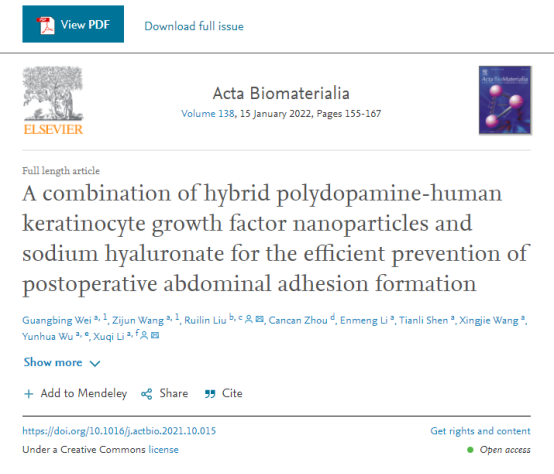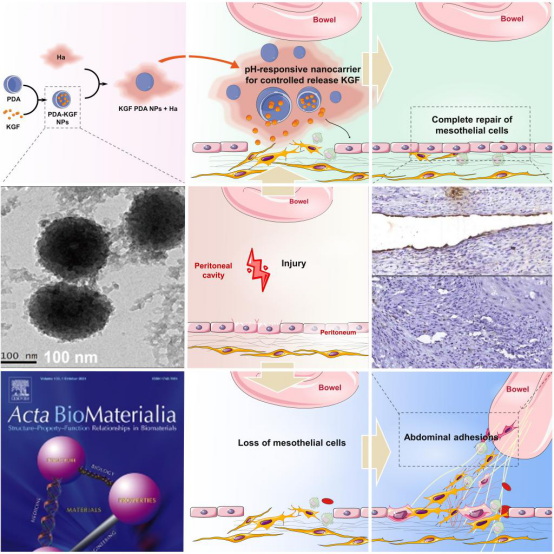The latest research results of Li Xuqi's team from Department of General Surgery of the First Affiliated Hospital of Xi 'an Jiaotong University (XJTU) were online published as an Article entitled A combination of hybrid polydopamine-human keratinocyte growth factor nanoparticles and sodium hyaluronate for the efficient prevention of postoperative abdominal adhesion formation in the first issue of ActaB iomaterialia in 2022, an authoritative journal in the field of biomaterials.

Postoperative abdominal adhesion is a common complication after abdominal surgery. This unavoidable complication can cause multiple severe issues, such as female infertility,small bowel obstruction, postoperative abdominal and pelvic pain, and reoperation difficulty,etc. Although extensive research on postoperative abdominal adhesion has been conducted, no agents with reliable effect and mild side effects have been developed. Currently, the most common method for preventing postoperative abdominal adhesion employ absorbable gels or films to block the injured peritoneal surface for at least 5-7 days, whereas the effect upon reducing adhesion is unsatisfactory, probably due to neglecting the role of peritoneal mesothelial cells in the biological process of adhesion formation. Consequently, the development of a simple and economic strategy for the prevention of postoperative abdominal adhesion is desirable.
Since 2016,the team led by Li Xuqi has begun to investigate the mechanism of peritoneal mesothelial cells involved with abdominal adhesion. The team has found that keratinocyte growth factor (KGF) may exert mitogenic effects on mesothelial cells, and developed a hybrid KGF-sodium hyaluronate (Ha) gel to prevent the formation of abdominal adhesions in ratmodels, isolated the injured peritoneumusing the barrier and simultaneously reconstructed the intact mesothelial cell layer at an early stage. However,the stability of KGF is poor,its biological half-life is short and it is susceptible to physiological microenvironments, intraperitoneally administered KGF does not maintain biological activity for long periods in the presence of various biological enzymes. Therefore, it is of significance to further develop a method to maintain the stability of KGF in vivo.
Based on preliminary research, Li Xuqi's team cooperated with Professor Liu Ruilin, a pharmaceutical expert from Xuzhou Medical University and made attempts to preparemussel protein-inspired biomimetic self-assembled nanoparticles for coating with KGF. When KGF was loaded with sodium Ha gel, the prevention effect of postoperative abdominal adhesion could be significantly improved. The hybridgels remain in asemi-fluid state in vivo, allowing them to be distributed throughout the abdominal cavity with changes in position and avoid direct contact between thei njured peritoneal surfaces. More importantly, thehy bridgels have the ability of pH- and enzyme-responsive"semi-intelligent" controlled release of KGF. The microenvironment inflammatory responseand hypoxia after peritoneal injury can reduce the extracellular pH, and stimulate the sustained and smooth release of KGF, thus continuously promoting the orderly regeneration and repair of the injured peritoneal mesothelial cell layer. This method yields promising application prospect in preventing postoperative abdominal adhesion, which is acommon surgical complication.

Wei Guangbing, Deputy Chief Physician from Department of General Surgery, and Wang Zijun, a graduate student(2020 enrollment)in major of Surgery of our hospital, were the co-first authors. Li Xuqi, Associate Research Professor/Deputy Chief Physician from our hospital was the corresponding author, and Associate Professor Liu Ruilin from Xuzhou Medical University was the co-corresponding author of this article. The researchwork has been conducted relying on the talent highland experimental platform of ourhospital, and our hospital is the first affiliation of this study. Acta Biomaterial, belonging to Elsevier, is one of the top-notched journals inthe field of biomaterials, classified as Area I by Chinese Academy of Sciences and JCR. Ther ecent impact factor exceeds 10, which is estimated to behigher than 12 in 2022.
This study is financially supported by Surface Project of National Natural Science Foundation of China and the funding project of XJTU.
Articlelink:https://www.sciencedirect.com/science/article/pii/S1742706121006826